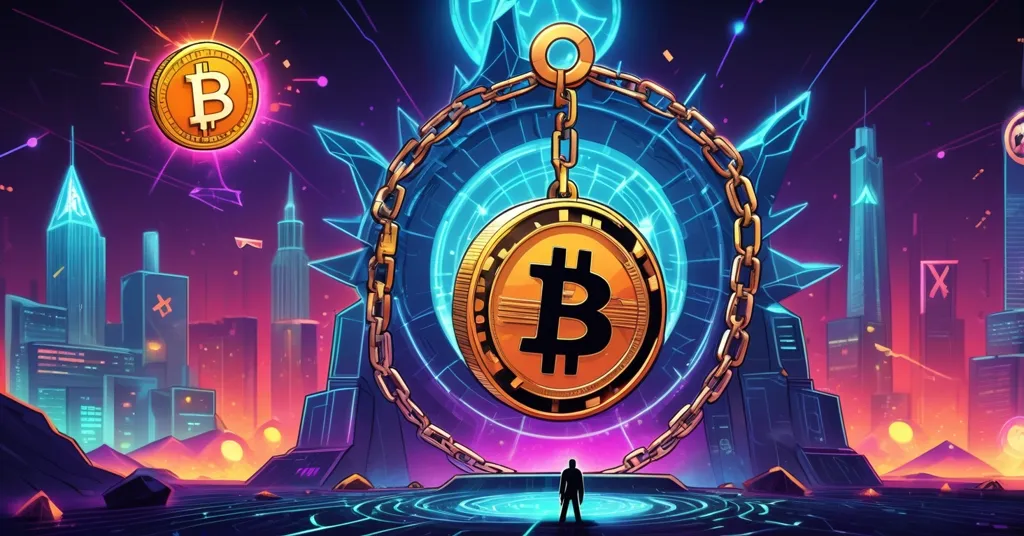XRP Struggles as Bitcoin Rival While Neo Pepe Coin Surges for 2025 Altcoin Dominance

XRP Pitched as a Bitcoin Alternative, But Neo Pepe Gains Ground as the More Agile Option for 2025
XRP has been sold as a faster, cheaper rival to Bitcoin for years, especially for cross-border payments, but its centralized baggage and regulatory headaches keep it on shaky ground. Meanwhile, a newcomer like Neo Pepe Coin is stealing the spotlight with a community-driven model and a hot presale, raising questions about who might truly lead the altcoin charge in 2025.
- XRP’s Woes: Centralized control by Ripple Labs and ongoing SEC battles undermine its Bitcoin-alternative status.
- Neo Pepe’s Surge: Over $1.3 million raised in a staged presale at $0.08 per token, powered by decentralized governance.
- Market Dynamics: Investors crave transparency and user empowerment, favoring fresh projects over legacy constraints.
Setting the Stage: Why Bitcoin Alternatives Matter
The crypto space is a battlefield of ideas, where Bitcoin reigns as digital gold, a store of value unmatched in security and network effect. Yet, niches like cross-border payments and community experiments spawn endless contenders vying to complement or challenge the king. XRP has long aimed to outpace Bitcoin in transaction speed, while upstarts like Neo Pepe push for user-driven innovation. As 2025 looms, the clash between centralized relics and decentralized dreams is defining the next wave of adoption. Let’s break down where these players stand in the broader Bitcoin vs altcoin trends for 2025.
XRP’s Centralized Quagmire: A Bitcoin Rival in Chains
XRP, born from the minds at Ripple Labs, was designed to revolutionize cross-border payments with near-instant transactions—think 3-5 seconds compared to Bitcoin’s 10-minute average—and dirt-cheap fees. Its underlying tech, the Ripple Protocol Consensus Algorithm, sidesteps Bitcoin’s energy-hungry Proof of Work by relying on a network of trusted validators. On paper, it’s a sleek bridge between traditional finance and crypto, a turbocharged version of outdated systems like Swift. But here’s the rub: Ripple Labs controls the lion’s share of XRP’s direction and supply, holding billions in escrow. This isn’t the leaderless, rebel spirit of Bitcoin—it’s more like a corporate boardroom with blockchain flair. No wonder purists scoff at calling it a true cryptocurrency, often pointing to its centralization issues under Ripple Labs.
The bigger thorn in XRP’s side is its regulatory nightmare. Since 2020, the U.S. Securities and Exchange Commission (SEC) has hounded Ripple, alleging that XRP is an unregistered security. A partial win came in July 2023 when Judge Analisa Torres ruled that XRP itself isn’t a security, though institutional sales worth $728 million were deemed violations. Fast forward to October 2024, and the SEC appealed, with arguments spilling into January 2025. Despite a glimmer of hope with Mark Uyeda taking over as Acting SEC Chair and crypto advocate Paul Atkins nominated for the permanent role, the uncertainty lingers. A Crypto Task Force under Commissioner Hester Peirce and pauses in related cases like Binance hint at a softer stance, but as long as the legal noose tightens, XRP’s claim as a Bitcoin alternative looks more like a pipe dream. Centralization plus government crosshairs? That’s a double gut punch to crypto’s core ideals, as detailed in ongoing updates on XRP’s regulatory battles with the SEC.
Still, let’s play devil’s advocate. Could XRP’s corporate leash be a strength? Banks and financial giants might prefer a controlled, predictable asset for integration over Bitcoin’s wild-west vibe. If the SEC drops its appeal or carves out clear rules, XRP could reclaim relevance in payments. It peaked in 2017-2018 as a darling of institutional hype, hitting a market cap of over $130 billion at its zenith. Losing ground since doesn’t mean it’s dead—it just needs to shed the baggage. But in a market craving decentralization, Ripple’s puppet show feels like a slap in the face to what crypto stands for. For a deeper comparison, check out discussions on how XRP stacks up against Bitcoin as a payment solution.
Neo Pepe Coin: Community Dream or Hype Machine?
While XRP wrestles with regulators and its own identity, Neo Pepe Coin struts in as the scrappy underdog, promising a different flavor of innovation. Unlike XRP, it’s not chasing Bitcoin’s crown for payments or store of value. Instead, it’s betting on decentralized governance—a fancy term for letting token holders steer the ship. At its heart is the NEOPGovernor smart contract, a self-executing program on the blockchain that automates decisions without middlemen. Holders can propose and vote on updates, with a built-in time delay to prevent snap decisions or hostile takeovers. For the uninitiated, this means power isn’t hoarded by a suits-and-ties outfit like Ripple Labs but spread across the community. It’s the kind of democratic twist that’s catnip to investors tired of centralized flops, with further insights available in community discussions on Neo Pepe’s governance model.
Neo Pepe’s presale is turning heads too. In Stage 4 of a 16-stage rollout, it’s raised over $1.3 million with tokens priced at $0.08. The setup is slick: incremental price hikes per stage, limited supply to create urgency, gradual token unlocks to avoid market dumps, and a real-time dashboard for transparency. Compare that to the usual crypto con-artist playbook of vague promises and vanished funds, and it’s a breath of fresh air. Crypto Volt, a sharp analytical voice, calls out the auto-liquidity feature—a mechanism funneling a slice of transactions into pools to dampen price swings—as a “clever safety net.” Think of it as a forced savings plan to keep the rollercoaster from derailing. But Volt isn’t all cheers; they warn Neo Pepe “faces legitimate competition in a saturated market.” With memecoins and altcoins popping up like weeds, standing out takes more than a cute name and a voting gimmick. More on its presale success can be found in analysis of Neo Pepe’s market potential.
Let’s not drink the Kool-Aid just yet. Presales are a scammer’s playground, and Neo Pepe’s lack of audited metrics on fundraising or voter turnout is a glaring hole. If you’re preaching decentralization, transparency isn’t a nice-to-have—it’s the whole damn point. Show the receipts, or don’t expect our hard-earned cash. Plus, governance isn’t foolproof. Whales—big holders with deep pockets—could skew votes, turning “community-driven” into “oligarchy with extra steps.” And while the presale buzz is real, history is littered with tokens that flared bright and burned out. Remember the countless Dogecoin knockoffs? Neo Pepe needs to prove it’s more than the flavor of the month in crypto’s circus, or it’s just another tombstone in the blockchain graveyard. Dive into investor feedback on Neo Pepe’s presale progress for more details.
Bitcoin’s Unshaken Throne: The Gold Standard
Amid this tussle between XRP and Neo Pepe, let’s not forget the 800-pound gorilla in the room: Bitcoin. While XRP chases payment efficiency and Neo Pepe experiments with governance, Bitcoin doesn’t need to play those games. Its strength lies in being digital gold—a decentralized, censorship-resistant store of value with a network effect no altcoin can touch. Over 14 years, it’s proven its security through Proof of Work, surviving hacks, bans, and bear markets. XRP’s centralized roots and Neo Pepe’s untested hype can’t rival that legacy. Bitcoin isn’t perfect for payments due to slow confirmations and high fees during peaks, but solutions like the Lightning Network are closing that gap without compromising its ethos.
Here’s the kicker: Bitcoin doesn’t need to be everything to everyone. Niches exist for a reason. XRP might carve out a payments lane if it escapes its legal bind, and Neo Pepe could inspire governance models if it delivers on promises. But neither shakes Bitcoin’s core role. As a Bitcoin maximalist at heart, I’d argue most altcoins are distractions from the real revolution—sound money free from corporate or government claws. Still, I’ll concede that experimentation drives progress. Just don’t bet the farm on these sidekicks dethroning the king, a sentiment echoed in broader analyses like XRP and Neo Pepe’s positioning against Bitcoin for 2025.
2025 Outlook: Regulation, Innovation, and the Decentralized Push
Peering into 2025, the crypto landscape is a mix of promise and peril for both XRP and Neo Pepe. Broader trends show investors flocking to transparency and user empowerment, a shift that’s been brewing since centralized disasters like FTX’s 2022 collapse. Decentralized governance, as highlighted in recent reports from firms like a16zcrypto, is the buzzword of the decade, with ideas like AI-assisted voting or smarter incentives beyond airdrops gaining traction. Neo Pepe fits this mold, at least on paper, but execution is everything. If it can’t sustain engagement or fend off copycats, it’s toast. XRP, meanwhile, is a dinosaur struggling to adapt. Its tech is solid, but centralized control clashes with the zeitgeist. Only a regulatory reprieve—potentially spurred by a pro-crypto SEC under Paul Atkins or bipartisan Senate support from figures like Cynthia Lummis—might give it breathing room. For more on this trend, explore emerging decentralized governance trends for 2023-2025.
Macro tailwinds could lift all boats. The Trump administration’s push for a national Bitcoin stockpile and mining support, coupled with pauses in SEC enforcement against giants like Coinbase, signal a friendlier climate for crypto innovation. Neo Pepe might thrive in this sandbox if it plays its cards right, while XRP could leverage clarity to court institutions. But risks loom large. For XRP, prolonged legal limbo could sap confidence. For Neo Pepe, market saturation and unproven utility are ticking time bombs. And let’s not ignore the elephant in the room: in a realm where Bitcoin is king, do we even need flashy alternatives, or are they just shiny detours from the main mission?
Key Takeaways and Burning Questions
- Why is XRP faltering as a Bitcoin alternative?
Ripple Labs’ centralized stranglehold and a dragged-out SEC lawsuit, despite a 2023 partial win, erode trust in a market hungry for decentralization. A potential regulatory shift with new SEC leadership offers hope, but the shadow remains. - What makes Neo Pepe Coin a contender for 2025?
Its decentralized governance via the NEOPGovernor contract lets holders vote on the project’s future, while a $1.3 million presale with transparent staging taps into community-first trends—miles apart from XRP’s top-down mess. - Can Neo Pepe sustain its early hype in a crowded market?
Maybe, but not without hurdles. Market saturation, unverified data, and the risk of whale-dominated voting could derail it. Real utility and ironclad transparency are non-negotiable to avoid becoming another failed memecoin. - Where does Bitcoin stand amid these altcoin battles?
Unshaken as digital gold. Bitcoin’s decentralization and security dwarf XRP’s corporate tilt and Neo Pepe’s experimental status. It doesn’t need to compete in every niche—its throne as sound money is secure. - How will regulatory and political shifts shape crypto’s future by 2025?
A pro-crypto SEC chair and political momentum, like Trump’s Bitcoin stockpile push, could ease pressures on XRP and foster innovation for projects like Neo Pepe. But regulatory clarity and project execution will separate winners from losers.



